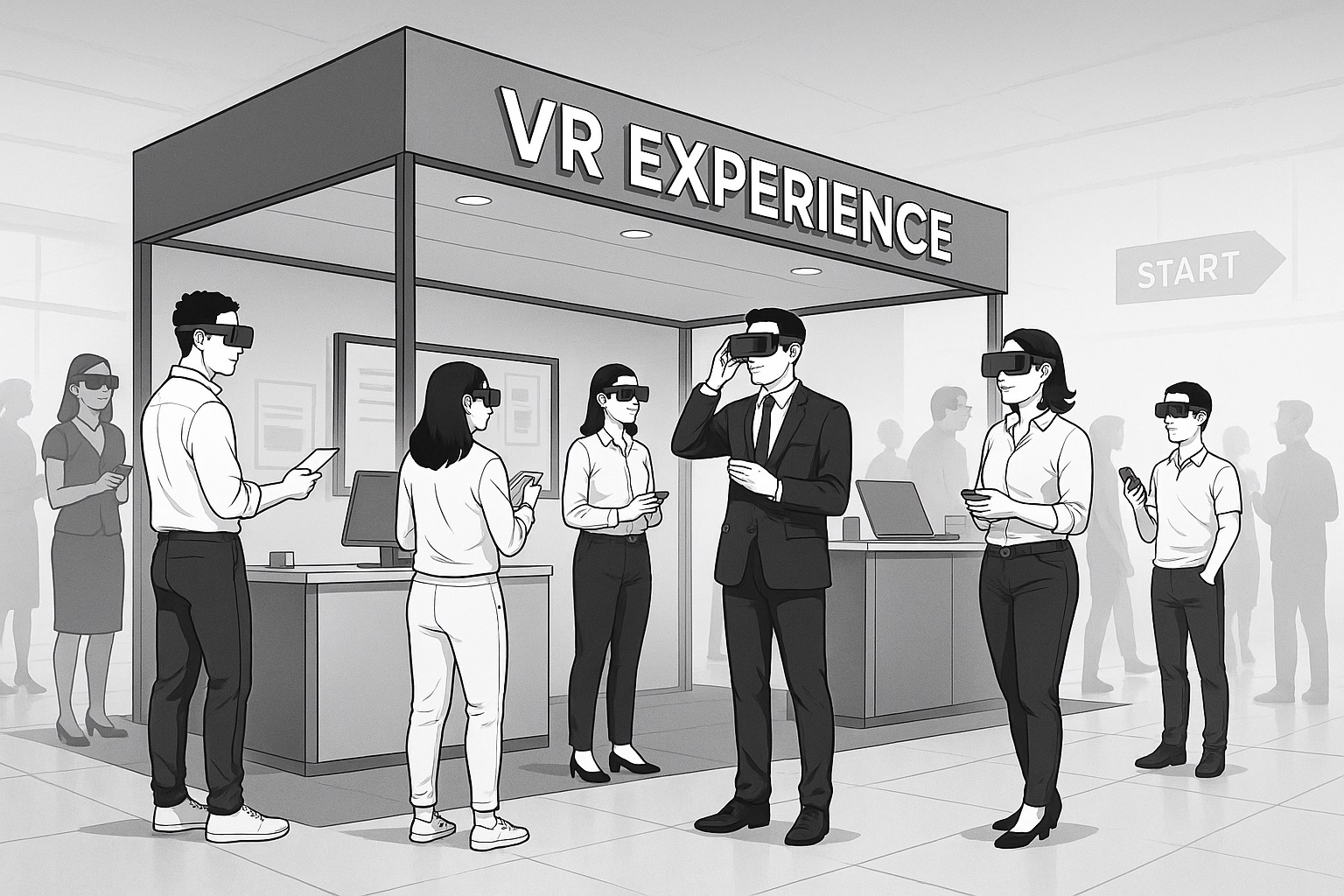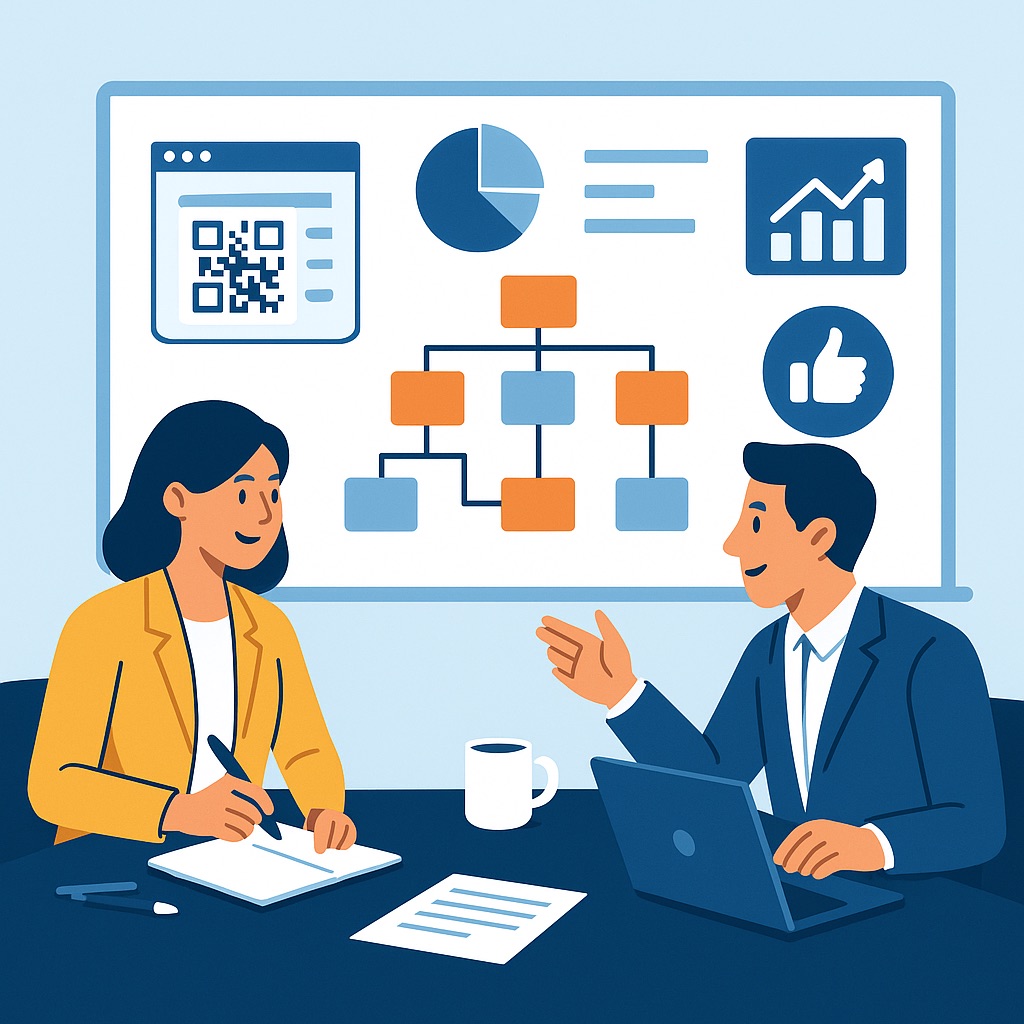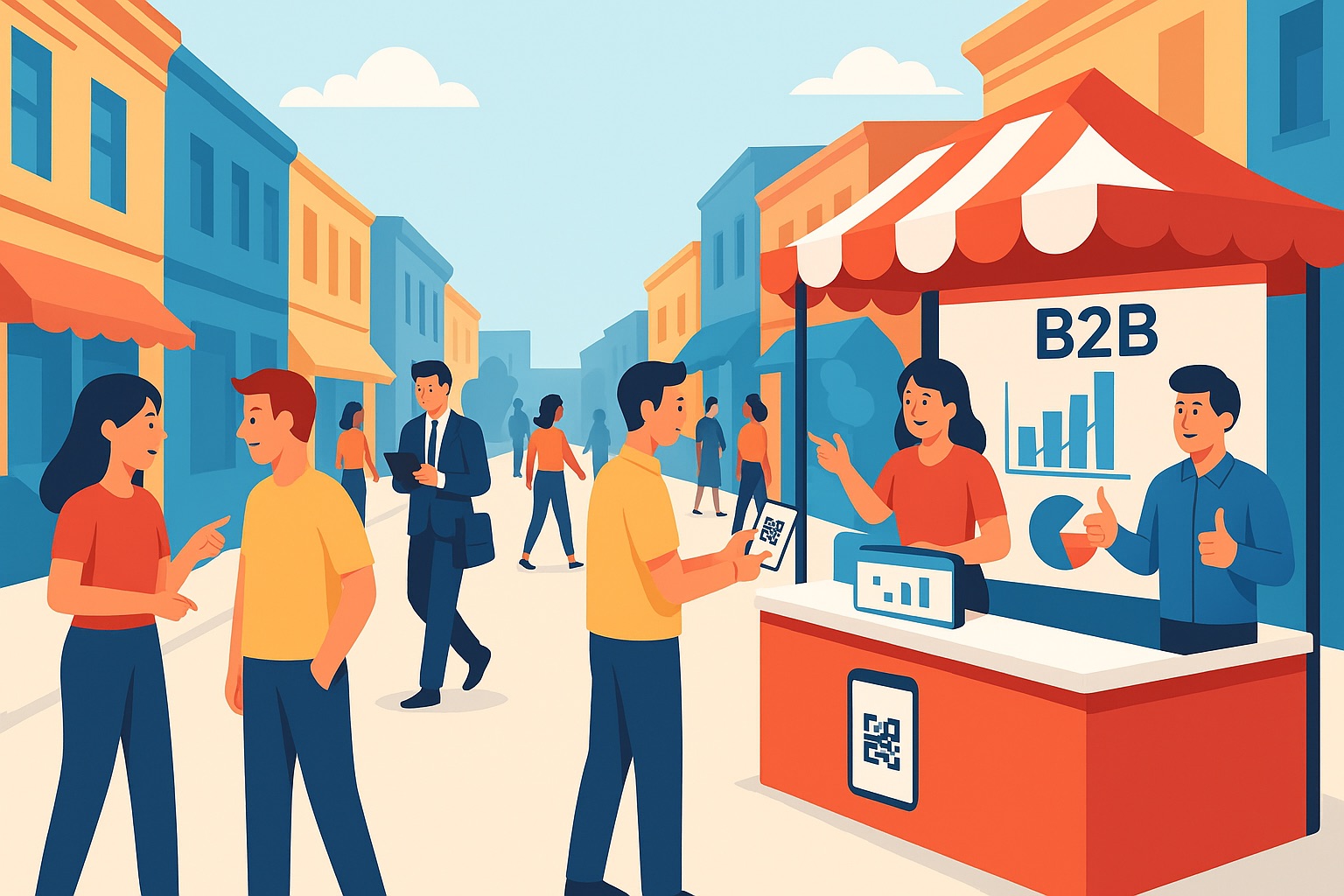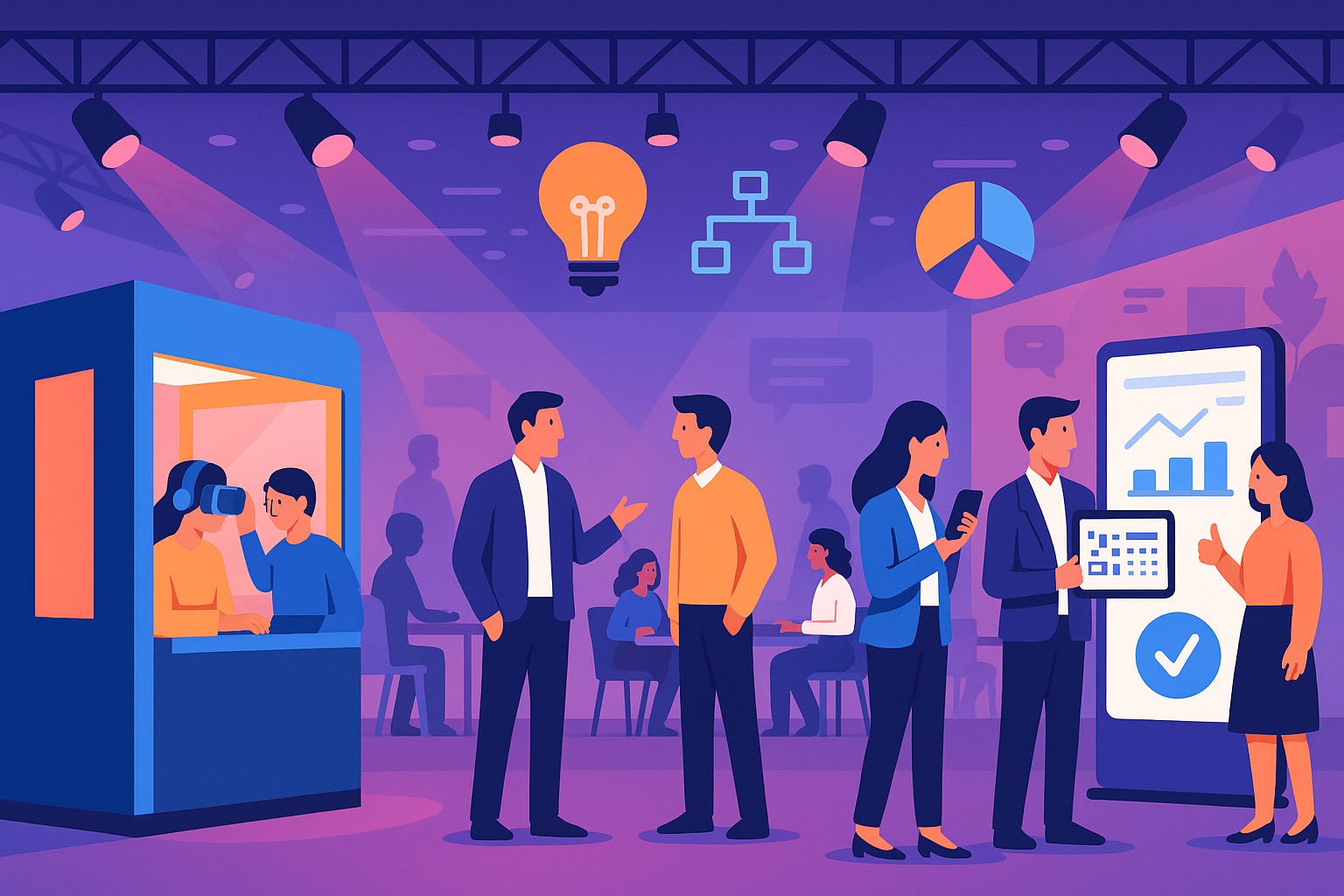Event and experiential marketing transforms passive attendees into active participants. At its core, it is the practice of designing immersive, hands-on interactions that create a real, memorable connection between a brand and its audience. The goal is to move past simply making an impression and start building genuine, positive feelings and lasting relationships that drive business forward.
Moving Beyond The Booth Mentality
Traditional event marketing often feels like a logistics game. You fight for a good spot on the trade show floor, set up a booth, and hand out flyers to passersby. It is all about being there. Experiential marketing, on the other hand, is about being there and being unforgettable. It asks a better question: “How do we make our brand the one thing people are still talking about long after they've gone home?”
Instead of just telling people about your brand, you invite them to become a part of its story. This approach is built on interaction, emotion, and creating shareable moments that keep the conversation going beyond the event floor. It is the difference between having a booth at a conference versus creating an interactive playground that becomes a highlight of the entire show.
Shifting Focus From Impressions to Interactions
The global events industry is booming, with projections showing it could grow from around $736.8 billion in 2021 to a staggering $2.5 trillion by 2035. This growth is fueled by a critical insight: two-thirds of attendees say they feel more positive about a brand after engaging with it at an event. That is the power of creating a real emotional connection.
This move toward engagement is a smart, strategic way to hit key business goals at conferences, trade shows, and expos.
- Lead Generation: An interactive experience does more than just scan a badge; it captures rich, qualified data. A fun activity creates a natural opening for a real conversation.
- Brand Awareness: A unique, shareable moment turns attendees into your best brand advocates. A well-designed photo or video experience, for instance, makes every participant a potential marketer.
- Community Building: When you create a space for genuine connection, you build a loyal community. People who share a great experience do not just bond with your brand; they bond with each other.
Traditional vs Experiential Event Marketing
This table breaks down how the focus and results differ between the two approaches.

The shift is from a numbers game to a relationship-building one, and the results speak for themselves.
The real value of an event isn’t measured by how many people walk by your booth, but by how many people walk away with a memorable story to tell about your brand.
That focus on creating memorable stories is what separates a forgettable presence from a powerful, ROI-driven strategy. If you're looking to dive deeper into the core principles, you can explore more potent event marketing strategies. By adding hands-on elements, you are not just boosting metrics; you are building the kind of brand love that fuels loyalty and growth for years to come.
How Experiential Strategies Drive Tangible ROI
Every event activation, no matter how clever, must answer to the bottom line. It needs to justify the investment with clear, measurable returns. This is where the true power of event and experiential marketing comes into play. It connects immersive activities directly to core business goals like lead generation, brand awareness, and community building.
A well-designed experience is a strategic tool. By focusing on interaction, brands can move past outdated metrics like foot traffic and start measuring what actually matters: genuine engagement and lasting impact.
From Badge Scans to Quality Leads
We have all experienced the quick, transactional badge scan at a booth. Traditional lead generation often stops there, providing a name and email but little context.
Experiential marketing flips this script. When attendees choose to participate in an activity, like an interactive game or a content creation station, they are naturally more open to a real conversation. This gives you a chance to gather deeper, more qualified data. You are no longer just collecting contact info; you are learning about their interests, pain points, and buying intent, all within a positive, memorable moment.
For example, a branded interactive survey can feel like a fun quiz, personalizing content for attendees on the spot. But on the back end, it is a goldmine of preference data for your sales team, instantly becoming a powerful lead qualification tool.
Creating Authentic Brand Advocates
Brand awareness is not about how many times people see your logo. It is about what they feel and, more importantly, what they say about you. Unique, shareable moments are the engines of modern brand advocacy. Give attendees a remarkable experience, and you empower them to become your most authentic marketers.
What do people post on social media from events? It is rarely a picture of a brochure. It is a photo of them having fun, a video of a cool interaction, or a personalized piece of content they helped create. These user-generated posts are infinitely more credible and have a much wider organic reach than any corporate post.
An experiential activation that generates 1,000 pieces of user-generated content isn’t just one marketing touchpoint. It's potentially 1,000 individual endorsements broadcast to thousands of different networks.
This is where tech like a custom AI Photo Booth or a digital photo booth becomes so valuable. By baking branding directly into instantly shareable photos and videos, every piece of content becomes a miniature marketing campaign, pushing brand reach far beyond the event floor. You can explore a ton of experiential marketing ideas and strategies that are brilliant at turning attendees into advocates.
Nurturing Community and Connection
At their heart, events are about people connecting with other people. Experiential strategies can intentionally design spaces and activities that build those connections, fostering a strong, vibrant community around a brand.
Shared experiences create common ground. They build relationships not just between a brand and an attendee, but between attendees themselves. This transforms a one-off event interaction into a genuine sense of belonging.
- Interactive Displays: A real-time social wall or a dynamic photo mosaic displaying attendee content creates a visual hub for the community, encouraging more people to participate.
- Collaborative Activities: Team-based games or friendly challenges are a low-pressure way to spark networking and forge bonds that last long after the event wraps up.
- Story Collection: A video testimonial booth is a fantastic way to invite your community to share their stories. It makes them feel heard and valued, all while giving you powerful, authentic social proof to use later.
Ultimately, these strategies ensure that every photo taken, every game played, and every conversation had links back to a tangible business outcome. They turn event spending into a measurable investment that grows brand awareness, generates high-quality leads, and builds a loyal, engaged community.
Mapping the Attendee Journey from Start to Finish

A great experiential strategy is about more than a single moment. It involves designing a complete journey that engages your audience before they arrive and keeps the conversation going long after they have left. This is how you turn a one-off activation into a lasting brand relationship.
Thinking about the entire journey lets you build anticipation, deliver a great experience on-site, and follow up in a meaningful way. To nail the planning, understanding how to create a customer journey map is a game-changer. It helps you visualize every touchpoint.
This strategic thinking pays off. A staggering 96% of marketers say that personalized experiences at events directly boost sales. But 21% of professionals admit that attracting the right people is their biggest hurdle, tied with keeping them engaged. Mapping the journey helps tackle all of it.
The Pre-Event Phase: Building the Hype
The experience starts weeks or even months before the doors open. The pre-event phase is all about building excitement and making sure your activation is one that nobody wants to miss.
Here is how to build buzz beforehand:
- Targeted Social Campaigns: Drop teasers of your experience on social media. A quick video clip or a behind-the-scenes shot of the setup can spark curiosity.
- Personalized Invitations: Send invites that hint at the interactive elements you have planned, making people feel like they are on a VIP list.
- Early Access Fun: A pre-event virtual photo booth lets registrants create branded content from home. This content can then be displayed on a social wall at the live event.
Get this right, and you will turn passive ticket-holders into eager fans who show up ready to engage.
The During-Event Phase: Delivering the "Wow"
This is showtime. Your focus shifts to delivering an experience that is seamless, fun, and unforgettable. The magic happens when an attendee walks up to your space and leaves with a smile, all without a single hiccup.
The best on-site experiences feel effortless for the attendee but are meticulously planned behind the scenes. The magic is in making complex interactions feel simple and fun.
An AI Photo Booth, for instance, can be the star of the show. People can use simple text prompts to generate unique, one-of-a-kind images they cannot wait to share. The key is making the tech intuitive and the results instant for maximum participation and a flood of user-generated content.
The Post-Event Phase: Keeping the Conversation Going
Your job is not done when the event ends. The post-event phase is where you nurture the new connections and stretch the value of your investment. The goal is to keep the conversation alive and lock in positive memories.
A few solid follow-up tactics can make a difference:
- Shareable Content Galleries: Send everyone a link to a branded gallery with all the photos and videos from your activation. This prompts another wave of social shares.
- Personalized Follow-Ups: Use the data you gathered to send targeted messages. Mention the specific interaction they had with your brand to make it feel personal.
- User-Generated Content Campaigns: Showcase the best content created by your attendees on your own social channels. It is a great way to give them a shout-out and show the reach of your activation.
By designing a full before, during, and after strategy, you create a cohesive brand story that sticks with people and delivers real, long-term results.
Using Technology to Create Immersive Experiences

Modern event technology is the secret sauce behind today's most engaging, measurable, and scalable event and experiential marketing. The right tools can transform a simple brand activation into an unforgettable interaction. Tech is no longer just a gimmick; it is a strategic asset for collecting data, amplifying your message on social media, and creating moments that drive business results.
When integrated thoughtfully, technology adds real function, not just flash. It turns passive attendees into active participants and co-creators of your brand's story. That shift makes all the difference at conferences, trade shows, and corporate events.
Amplifying Engagement with Interactive Content
The best brand experiences invite people to get involved. Technology offers countless ways to make this happen, turning a basic booth visit into a hands-on moment that forges a stronger connection between an attendee and your brand.
An AI-powered photo booth, for example, is not a standard point-and-shoot. It can transform simple text prompts into personalized, one-of-a-kind images. An attendee is not just posing for a picture; they are using their own creativity to generate a unique piece of branded art. Suddenly, every snapshot becomes a personal, shareable asset. You can learn more about how to use an online photo booth for successful event engagement to see exactly how this works.
The most effective event technology seamlessly blends into the consumer’s life while still standing out enough to make them stop and take notice. It should feel both natural and remarkable.
Capturing Authentic Stories and Insights
Some of the most valuable takeaways from any event are authentic feedback and user-generated content (UGC). Technology now makes it easier than ever to capture these moments in real-time, giving you powerful assets for post-event marketing.
A video testimonial booth is a perfect example. It creates a structured, low-pressure space for attendees to share their honest stories and experiences on camera. Instead of awkwardly chasing people for quotes, you build a dedicated hub for story collection. The result is a library of powerful social proof to fuel campaigns for months.
Likewise, an interactive survey can gather crucial data in a way that feels like part of the fun. By personalizing the content an attendee sees based on their answers, you deliver immediate value while quietly collecting important lead qualification info on the back end.
Extending the Event Lifespan
The magic of your experiential marketing should not fizzle out when the event ends. Technology is key to extending the life and reach of your activation, creating a digital ripple effect that continues to deliver value long after everyone has gone home.
This can be done with a few key tools:
- Virtual Event Microsites: These can serve as a digital home for all the great content from your event. A microsite can host photo galleries, video highlights, and other resources, keeping the community connected.
- Live UGC Displays: A real-time social wall or photo mosaic projected at your event creates a dynamic focal point. It showcases attendee content as it is posted, encouraging more people to join in.
- Digital Content Delivery: Instantly sending branded photos and videos straight to attendees' phones via text or email is a must. This makes social sharing frictionless and ensures your brand travels far beyond the event venue.
Integrating the right technology transforms your event from a standalone moment into a powerful, multi-faceted campaign. It ensures every interaction is an opportunity to engage, capture data, and amplify your brand's message.
Integrating Hybrid Models and Sustainable Practices
A modern event and experiential marketing strategy must do more than impress the people physically in the room. It needs to connect with audiences wherever they are and resonate with their values. This is where hybrid event models and sustainable practices become core to a successful activation. By weaving together the physical and digital, we can create a unified brand moment that pulls in both in-person and virtual attendees.
A brand’s commitment to the planet is a huge factor for attendees now. Ticking the "green" box is not just good for PR; it is a genuine way to build brand affinity and connect with a more conscious consumer.
Crafting a Unified Hybrid Experience
Hybrid events offer the best of both worlds: the energy of a live gathering combined with the reach of a digital broadcast. The trick is not to run two separate events in parallel. The goal is to create one cohesive experience where everyone feels equally included, whether they're on the floor or on their couch.
Experiential elements are the glue that holds these two worlds together.
Interactive elements should be accessible to everyone. A digital photo booth, for instance, can be used by attendees at the venue via a simple QR code, while virtual participants get a link on the event's microsite. The user-generated content from both streams can then feed into a single, real-time social wall or photo mosaic, creating a shared, living picture of the entire event community.
The goal of a hybrid experiential activation is to make the virtual audience feel like they are part of the main event, not just watching it from the sidelines.
Embracing Sustainability in Your Event Strategy
The demand for eco-conscious events is only getting louder. While hybrid events already offer wins like broader reach and richer data, sustainability has become a make-or-break factor for many. Around 70% of attendees say that green initiatives are a key part of their decision to attend an event. The practices getting the most traction are using recycled materials (48%), cutting down on plastics (44%), and sourcing locally (34%). You can discover more insights about event marketing statistics to see how brands are adapting.
This shift is a golden opportunity for brands to lead with their values and weave sustainability into their experiential story.
Here are a few practical ways to make activations greener:
- Go Digital-First with Collateral: Ditch the paper brochures. Instead, use QR codes that link to dynamic digital content. You are not just reducing waste; you are giving attendees a trackable, interactive experience.
- Design for Reusability: Build modular, durable booth structures and displays that can be packed up and used again. It is a smart way to minimize waste and cut long-term costs.
- Partner with Eco-Conscious Vendors: Your choice of partners says a lot. Work with caterers who source locally or tech providers who prioritize energy efficiency. It all adds up and reflects your brand’s commitment.
By blending hybrid accessibility with real sustainable practices, your event and experiential marketing becomes more inclusive, responsible, and impactful. This is not just about generating leads; it is about building a deeper, more meaningful connection with your audience.
Measuring Success in Experiential Marketing

If you are going to invest in an activation, you have to prove its value. This means looking past simple foot traffic and focusing on key performance indicators (KPIs) that connect your event and experiential marketing efforts directly to business goals. A data-driven approach does not just show a clear ROI; it gives you the insights needed to make your next event even better.
Measuring what matters is the only way to turn your event spend from an expense into a strategic investment. The right metrics tell a story of engagement, reach, and influence that a simple headcount never could.
Moving Beyond Vanity Metrics
The first step in proving value is to stop obsessing over surface-level numbers. Metrics like booth visitors or total attendees are nice to know, but they do not tell you about the quality of interactions or the actual impact on your brand. A successful campaign is measured by engagement, not just presence.
We focus on metrics that show how deeply an attendee interacted with the experience and their potential to become a lead or a genuine brand fan.
The most important question isn't "How many people showed up?" but "How many people actively participated, shared their experience, and left with a stronger connection to our brand?"
This shift in focus requires a smarter set of KPIs that track audience behavior and feelings throughout their entire journey with your event.
Core KPIs for Experiential ROI
To get a complete picture of your event's success, you need a balanced mix of metrics covering lead generation, social media buzz, and brand perception. These KPIs provide a clear, quantifiable view of your activation's real impact.
Here are the essential metrics we track to prove ROI:
- Lead Quality Over Quantity: It is not about how many badges you scan, but how many qualified leads you generate. An interactive experience, like a survey that personalizes content, is a fantastic tool for capturing valuable data like purchase intent, role, and specific interests.
- User-Generated Content (UGC) Volume: The number of photos, videos, or posts created by attendees is a direct measure of how engaging your event was. A high volume of UGC shows that your experience was compelling enough for people to want to capture and share it.
- Social Media Engagement Rate: Go deeper than just reach. Track shares, mentions, and how often your event hashtag is used. These actions show that your branded content resonated enough for attendees to broadcast it to their own networks.
- Post-Event Brand Sentiment: Use social listening tools to analyze how people are talking about your brand after the event. A positive shift in sentiment is a powerful indicator that you made a real emotional connection.
By tracking these KPIs, you can build a strong business case for your experiential strategy. When planning your content, it helps to keep some event content marketing best practices in mind to ensure every asset is designed to be measured.
Using Technology to Track What Matters
Measuring these advanced KPIs is nearly impossible without the right event technology. The analytics built into modern activation tools are what make accurate tracking and reporting a reality.
For instance, a virtual photo booth does not just create fun pictures. Its backend analytics can precisely track every single piece of content shared via email, text, or social media. This gives you concrete data on content shares and estimated social reach, taking the guesswork out of your ROI calculations. This data-driven approach lets you connect every dollar spent to a measurable outcome, proving the undeniable value of event and experiential marketing.
A Few Common Questions
Diving into the world of event and experiential marketing can feel like a lot. Let's tackle some of the most common questions we hear with practical, no-fluff answers to help you design experiences that actually work.
What’s the Very First Step in Planning an Experiential Campaign?
Before you dream up a wild concept or get lost in the tech, you have to do one thing first: clearly define your primary goal. Everything else hinges on this.
What are you actually trying to accomplish? Are you looking to hand your sales team a list of high-quality leads? Do you want to blow up on social media and boost brand awareness? Or is the aim to build a tight-knit community around your products? Your answer will steer every single decision, from the kind of activation you create to the metrics you'll obsess over later.
How Do You Actually Measure the ROI of an Experience?
Measuring the return on an experiential campaign is about so much more than just counting heads. To get a real sense of ROI, you need to track KPIs that connect directly back to the goal you set in step one.
- Social Amplification: Look at the amount of user-generated content (UGC) pouring in. Track your branded hashtag's reach and see how many people are sharing content from your tech, like a digital photo booth. These numbers tell you how far your brand's story traveled on its own.
- Lead Quality: Do not just tally up emails. Use interactive surveys or personalized content to learn about your leads' purchase intent, company size, and biggest challenges. This is how you score for quality, not just quantity.
- Brand Sentiment: Fire up your social listening tools to see what people were saying about your brand before the event, and then check again after. A measurable jump in positive chatter is a huge win and a powerful sign of success.
How Can Small Businesses Even Afford Experiential Marketing?
You do not need a Super Bowl-sized budget to create an experience that sticks. For small businesses, the magic is not in the scale, it is in the creativity and genuine connection.
A clever pop-up shop, a unique product sampling program, or a smart interactive installation at a local fair can create major buzz. For example, a cost-effective digital photo booth can instantly turn a small gathering into a content-creating machine. The secret is to create a focused, unforgettable moment that truly connects with your niche audience and makes them want to share it.










-p-500.webp)



.jpeg)















